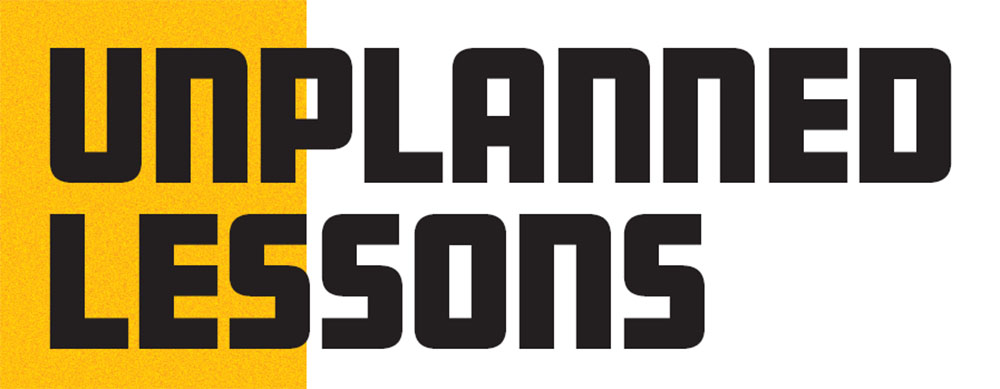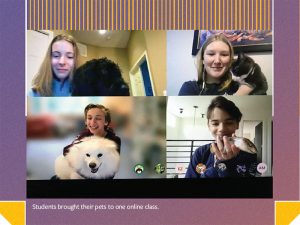
By Paul Hagen, Director of Student Well-Being
MY FIRST YEAR OF TEACHING, AT A TINY INDEPENDENT SCHOOL ON THE Big Island of Hawaii, was transformative. I was young, did not have a degree in education, had never taught before, and felt utterly ill-equipped to manage a class. Like so many new teachers, I was hungry for any guidance I could get from more seasoned colleagues and I frequently asked them for advice. “Unplanned lessons are the best,” one colleague told me, “they have the biggest impact.” Having taught for decades, she understood that school was more than just formal lessons and that deep learning could just as easily come in the hallways as it did in the classrooms. As an obsessive planner myself, I was skeptical. Surely the most impactful lessons were the ones that were carefully planned and masterfully delivered, I thought. Of course, her point was not that I should skip lesson planning altogether or that I should not put effort into designing the best class experiences I could. Instead, she was encouraging me to leave room in my planning for unexpected moments and the meaningful learning that can be found in them.
“UNPLANNED LESSONS ARE THE BEST,” ONE COLLEAGUE TOLD ME, “THEY HAVE THE BIGGEST IMPACT.”
 The truth of that advice has remained with me for the decade and half since. Schools are so much more than the sum of their academic courses, and there are many lessons to be learned outside of the classroom. Indeed, for many, it is in the interstitial spaces, not the classrooms, in which the most memorable learning takes place. It is in these spaces—the lunchroom, hallways, and sports court—and the unplanned interactions that take place in them that students learn who they are, what they value, and how to be part of a community. By being open to the unexpected and by remaining adaptable, we can capitalize on unplanned teachable moments.
The truth of that advice has remained with me for the decade and half since. Schools are so much more than the sum of their academic courses, and there are many lessons to be learned outside of the classroom. Indeed, for many, it is in the interstitial spaces, not the classrooms, in which the most memorable learning takes place. It is in these spaces—the lunchroom, hallways, and sports court—and the unplanned interactions that take place in them that students learn who they are, what they value, and how to be part of a community. By being open to the unexpected and by remaining adaptable, we can capitalize on unplanned teachable moments.
Shifting to remote education in early March 2020 was the most unexpected circumstance that any of us had ever faced in schools. In the early days, we realized that we needed to support not only students’ academic health through carefully designed virtual class experiences and exceptional pedagogical prowess, but that we would also need to support students’ social, physical, and mental health. So, PE classes and athletic teams went virtual and the biweekly Student Email provided health tips from our school nurse and athletic trainer. We encouraged students to get outside, held contests to see who could get the most steps, and provided optional community workouts. Counselors were available for individual online counseling sessions and advisors checked in frequently with each student in the school. The Student Email, which served as a community-building conduit of information, included timely resources that supported students’ mental health and encouraged self-care. Students connected socially during advisory sessions, community-wide contests, virtual dances, and online scavenger hunts.
HUMANS ARE HARDWIRED FOR FUN, AND DURING CHALLENGING TIMES IT IS IMPERATIVE THAT WE FIND WAYS TO HAVE FUN, TO LAUGH, AND TO PLAY
COVID-19 and the unexpected need to move school quickly to a remote platform forced us to find creative ways to support student well-being. It also provided a new opportunity to develop and practice new skills that are sometimes overlooked, but that are vitally important in an ever-changing and unpredictable world. While the lessons were many, three stood out to me.
LEARNING TO LIVE WITH AMBIGUITY
The future has always been unknowable, but we habitually trick ourselves into believing that we can predict the future and maybe even control it. We like to believe that we can plan away all the uncertainty that we face, and that there is a clear road map for tomorrow, and the next day, and the next. But the truth is we never really know what tomorrow will hold, and when COVID-19 arrived, the future felt more ambiguous than ever.
Many of us found that managing our own emotions in the face of uncertainty was especially challenging. We wanted to know the plan, to see the calendar, and to study the forecast. We wanted to know that with careful planning, we could chart out our own course and that nothing would interrupt our predetermined journey. But that’s not how life works. Instead, the future is unclear and life is full of ambiguity.
When we moved to remote learning, we were all confronted with more uncertainty than ever—What would the future hold? When would we be able to gather in groups? How long would we have to stay home? And while that uncertainty was frustrating and frightening, it was also a great opportunity to practice living with ambiguity. Students who master this skill—and the related skills of remaining flexible, seeing the humor in absurd situations, and responding creatively to unforeseen circumstances—are more resilient and better equipped to handle whatever the future throws at them.
PRIORITIZING SELF-CARE
Forced off campus and into quarantine, we found new opportunities for self-care. Many students found that they got more sleep, ate healthier foods, and maintained regular physical activity during their time of remote learning. Students creatively pursued ways to care for themselves, to connect socially, and to carve out time for activities that brought them joy. Many students took up new hobbies or revived old ones like baking, writing poetry, and photography. Some students committed to taking a walk, run, or bike ride every day. And several students reported that, although they could not physically be with friends and classmates each day, they were able to set up regular video calls with friends to maintain social connection. One student explained that she felt “closer with friends now than before” and that she hoped to maintain that closeness even after fully returning to campus.
The shift in schedule allowed students to reorganize their days and reprioritize what was meaningful or beneficial to them. The dramatic change in our experience meant that we were all more alert to well-being generally and were eager to support well-being in others. We talked more openly about well-being, encouraged others to care for themselves, and were more intentional about connecting with those we care about.
We have all lost something to COVID-19, but we have also gained a greater sense of the importance of self-care and well-being.
BUILDING STRONG COMMUNITY
Community is an evolutionary imperative—it’s a matter of survival. One of the things that students love most about schools—and especially about EPS—is the sense of community they have when they walk in the door. At EPS we pride ourselves on the fact that every student is known and celebrated for who they are, but maintaining a community online was a new challenge for us. While remote, we prioritized playfulness and fun. Humans are hardwired for fun, and during challenging times it is imperative that we find ways to have fun, to laugh, and to play. Laughter really is the best medicine, and groups that laugh together form tighter bonds and build stronger communities. Eastside Prep has always had a culture that puts a premium on laughter and playfulness, and that helped carry us through. In the end, because Eastside Prep had already invested in community prior to the arrival of COVID-19, we were well-prepared to maintain our tight-knit community once we went remote. A community like ours can only grow stronger in times of adversity.
COVID-19 forced us all to learn quickly how to adapt to a new set of circumstances well beyond our own control. By remaining adaptable, we were able to embrace the unplanned lessons in well-being that this unexpected circumstance provided. And sometimes, the unplanned lessons are the best.

